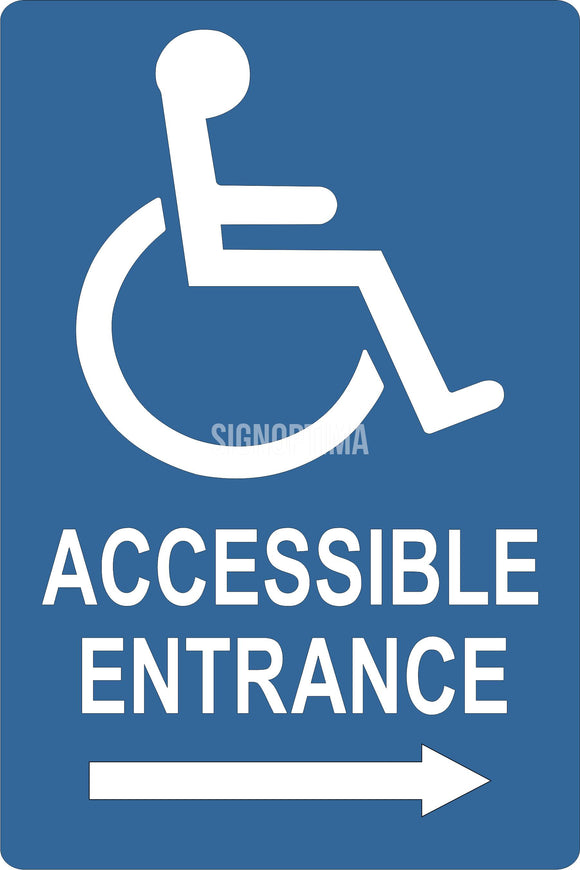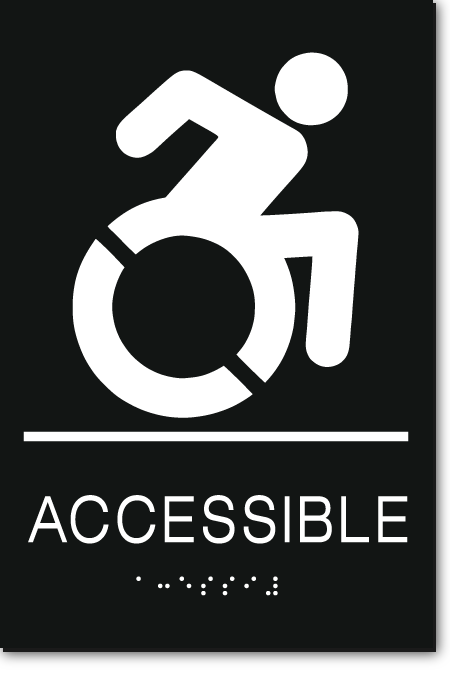ADA Signs: Necessary Devices for Inclusive Atmospheres
ADA Signage: Making Certain Accessibility and Compliance in Public Spaces
ADA signage plays a vital role in guaranteeing ease of access and conformity within public spaces, dramatically adding to an inclusive environment for people with specials needs. By sticking to ADA criteria, signs not only facilitates navigation yet also emphasizes an organization's commitment to variety and equal rights. As we explore the subtleties of ADA signs, from responsive attributes to make ins and outs, it's vital to take into consideration exactly how these aspects coalesce to support the legal rights of all individuals. What are the usual challenges companies deal with in preserving conformity, and how can future patterns in signage proceed to drive ease of access ahead?
Value of ADA Signs
In modern-day society, the significance of ADA signage extends beyond plain conformity with lawful mandates to personify a dedication to inclusivity and ease of access for all people. These indicators are necessary in developing settings where people with specials needs can browse public rooms with the very same convenience and self-reliance as those without handicaps. By offering clear and standardized info, ADA signage guarantees that everybody can access facilities, solutions, and information without barriers.
The importance of ADA signage lies in its capacity to enhance the top quality of life for people with specials needs by promoting equivalent accessibility. It gets rid of the barriers that could or else hinder their ability to get involved totally in neighborhood life. These indications serve as noticeable indicators of a company's commitment to variety and equal rights, mirroring wider social values that champion the rights and dignity of all people.
Additionally, ADA signage plays an important role in public safety and security. By assisting individuals to departures, bathrooms, and various other crucial facilities, it ensures that all people, regardless of physical capacity, can leave safely during emergency situations. In recap, ADA signs is not just a governing need however an effective device for promoting a fair and inclusive society.
Trick Elements of Conformity

Positioning is vital; indicators must be set up in places that are quickly visible and obtainable. Typically, signs must be mounted between 48 and 60 inches from the ground to ensure access for both standing and wheelchair customers. Tactile components, such as Braille, are vital for people with visual impairments, supplying critical info in a non-visual format.
High-contrast shades in between the text and background are essential to improve readability for people with low vision. The ADA mandates specific contrast proportions to make sure clearness. Furthermore, personality dimension is a vital consideration, with minimum elevation requirements determined by the checking out distance to make sure readability from different angles.
Design Factors To Consider for Ease Of Access
Designing accessible signage calls for a meticulous approach to ensure it meets the requirements of all customers, particularly those with impairments. The dimension of the text is equally important, with ADA guidelines recommending a minimum height based on watching distance to guarantee clarity.
Contrasting colors between text you can find out more and background are essential for visibility, specifically for individuals with aesthetic impairments. A high comparison ratio assists differentiate the message from its history, boosting readability under different lighting problems. In addition, responsive components, such as Braille and elevated characters, are important for individuals that are blind or have low vision. These components should be found at a constant elevation and position to make certain very easy accessibility and comprehension.
Furthermore, the placement of signs plays a significant duty in accessibility. Signs should be mounted in areas that are unobstructed and quickly obtainable. Making certain that signage is placed at appropriate heights and angles allows all customers, including those making use of mobility devices, to connect with them effectively.
Usual Mistakes to Stay Clear Of

One more widespread error is the inaccurate placement of signs. ADA standards define accurate elevation and location demands to make sure that indications are reachable and easily noticeable by all individuals, consisting of those making use of mobility devices. Ignoring these guidelines not just obstructs access but also runs the risk of non-compliance with legal standards.
In addition, inadequate comparison in between text and background is a frequent oversight. Sufficient contrast is essential for readability, specifically for individuals with reduced vision. Designers sometimes select shades that are aesthetically attractive however do not have the necessary contrast, rendering the text tough to discern.
Lastly, some designers fail to integrate tactile aspects, such as Braille, which are essential for individuals who are blind. Omitting these attributes not just results in non-compliance with ADA guidelines but likewise limits gain access to for a section of the population that depends on responsive info.
Future Trends in Signs
Developments in innovation and increasing awareness of inclusivity are forming the click to investigate future patterns in signage design. Digital signage, for circumstances, is evolving to consist of interactive features and real-time updates, which can be essential in providing vibrant details in public areas.
Another arising trend is the application of enhanced reality (AR) to improve user experience. AR-enabled signs can overlay digital info onto the physical environment, supplying visually impaired people with auditory or haptic comments. ADA Signs. This technology not just improves accessibility yet likewise develops an appealing experience for all customers
Sustainability is likewise a substantial element affecting signage fads. Green materials and energy-efficient illumination solutions are being focused on to straighten with worldwide ecological goals. Additionally, improvements in materials science are bring about the advancement of even more weather-resistant and long lasting indications.
Verdict
ADA signage plays an essential duty in ensuring access and compliance within public rooms by including responsive components, high-contrast colors, and tactical placement. The adherence to ADA requirements not just facilitates safe navigation for people with handicaps however additionally signifies an organization's commitment to diversity and inclusivity. By staying clear of common mistakes and welcoming future trends, public rooms can continue to progress these worths, ensuring that the legal rights and self-respect of all people are valued and supported.
ADA signage plays an indispensable function in ensuring availability and conformity within public areas, substantially adding to a comprehensive setting for people with disabilities. As we explore the nuances of ADA signs, from tactile features to develop complexities, it's essential to think about exactly how these components coalesce to support the legal rights of all individuals.In modern society, the significance of ADA signage extends beyond mere conformity with lawful mandates to embody a commitment to inclusivity and accessibility for all people. By giving standardized and clear information, ADA signs guarantees that everyone can access centers, services, and details without obstacles.
ADA signage plays an essential duty in ensuring accessibility and conformity within public spaces by including responsive elements, high-contrast shades, and strategic positioning. (ADA Signs)